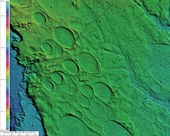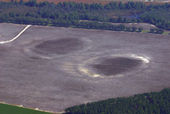George Howard is many things. He is the president of the Raleigh-based Restoration Systems mitigation bank and a conservationist; he is a history buff, a science geek, a cartographer. The 42-year-old family man is a talented amateur artist, a dedicated if unprolific fisherman and a politico whose office photos show him chummy with folks including Jesse Helms, Newt Gingrich, Lauch Faircloth and both George Bushes.
But what really gets Howard going - gets him talking a mile a minute, playing hooky from work and waking up at night - is his research into a geographical oddity known as the Carolina Bays.
These elliptical, wetland depressions, often rimmed with white, crystalline sand, are sprinkled along much of the North Carolina coast and parts of the eastern seaboard from Georgia to the District of Columbia. To Howard and those who share both his interest and his theory, these droplet-shaped dents (often choked with bay trees, hence the name) were most likely caused by a life-obliterating comet that landed on earth about 13,000 years ago: in geologic terms, quite recently. Howard wants to prove this, and he wants the world to take note.
He also knows how his theory can sound: nuts. (His word.) But it's not, and he's not. In fact, the theory has some impressive bona fides: The National Academy of Sciences published a paper he a nd a small group of fellow researchers wrote on their findings. National Geographic has produced a documentary on the subject, and Howard and his research team were recently asked to speak on the subject at the prestigious American Geophysical Union's fall meeting.
But he also knows that real believing requires seeing. His favorite quotation, borrowed from the state motto of North Carolina, is "Esse Quam Videri," - "to be rather than to seem." He wants to show the evidence to prove his case. And so he is delighted for the chance to show an interested party just what he's talking about: these Carolina Bays, from above.
The Grand Tour "You ready for the Grand Carolina Bays Tour?" Howard grins as the journey begins. The drive from downtown Raleigh to Fayetteville Regional Airport takes about an hour and a half - not nearly enough time for Howard to begin to say all he wants to say about what we're about to see. His primer begins with a basic refresher course on the evolution of the planet, veers into mythology, geology, ancient cultures, climate science, dinosaurs, botany; sidesteps frequently into humor and pop culture - and ends up deadly serious.
Howard would be aghast at the idea that it could be summed up, but here goes: 13,000 years ago, he says, a "cataclysmic event" happened when a comet hit the earth somewhere in the vicinity of the Great Lakes. It hit an ice sheet, acting like a big kid's cannon ball in the shallow end of a pool, throwing off a vast airborne splatter of "flying detritus," including extra-terrestrial particles that landed as far away as North Carolina. It's also possible that it created a shockwave that rippled across the landscape, dimpling it in the process, or that a little bit of both happened. Howard says it is certain that the comet decimated everything in its path, including the mammoths and the Clovis people, a well-documented Paleo-Indian civilization.
It Can Happen HereBelieving that such a thing happened as recently as 13,000 years ago implies that it could happen again, and possibly soon: not something most people are prepared to contemplate. But it's clear that for Howard, zipping down Interstate 95 and half-listening to CNBC's market-meltdown report on the radio, this possibility is neither abstract nor unimaginable. He waves his hand out the window, vaguely northward. "You wonder what came flying from that direction and landed here in these fields. Or what hell storm swept through and left these depressions."
Howard's fascination with that hell storm, these depressions and what it means for the future of our planet began years ago as a staffer for Lauch Faircloth in the US Senate. Studying a US Geological Survey map of Faircloth's farm, he noticed something unusual. "What are all those elliptical dotted lines on your farm, Senator?" he asked. Faircloth's casual reply: "Oh, you know, meteor holes."

Howard's "natural ferocious curiosity" took over, and he quickly became an expert on the subject. These "meteor holes," mostly too shallow to notice at ground-level, are clearly evident from above. First observed in the 1930s when the agricultural programs of the New Deal mandated county-by-county aerial photographs, they caused a sensation at the time. The number (more than 500,000 is the estimate), the symmetry, the fact that they all point in the same direction (toward Lake Michigan) - all gripped the public imagination, culminating in a 1933 piece in Harper's Monthly entitled "The Comet That Hit the Carolinas," by Edna Muldrow. But the scientific establishment ultimately pooh-poohed the comet theory, arguing that the bays were caused by wind, water and erosion over time, and the subject fell off the public radar.
If Howard has his way, that will change.
The Bays from AboveWhen we arrive at the airport, the fall weather is unseasonably warm. The skies are bright and clear, with a slight breeze, like a day in May. Our chartered plane is miniscule. It's so small we have to climb over its balsa-thin wings to pop into our seats through a Plexiglas-bubble hatch-top. We barely fit inside. Takeoff feels like racing down an empty street in a Matchbox car, until the thing lifts off - then it's just like floating.
We meander above the airport before crossing over I-95 and heading south into "Bays Territory." At first, nothing jumps out. And then it does. Two blurred, white-sand-edged ellipses, about 100-yards long and 30-yards wide, chase each other across a field of soy. Another one nearby forms a visible swamp. A ghostly pair of ovals lurk in a cleared field. Once you know what to look for, they're impossible to miss.
"They're everywhere," Howard says gleefully, snapping away with a long lens camera. The jigsaw of green fields, punctuated here and there by these graceful, sandy shapes, is a beautiful sight, but as we head over the border into South Carolina, Howard points out a less lovely landmark: "Make sure not to miss the big purple lagoons of pig piss!" He's not kidding. Countless pig farms pepper the horizon, their low-slung, silver-roofed pig houses each accompanied by a large, strangely purple, chemically treated lagoon of waste.
But as our flight path takes us over the Cape Fear River, the Bays are once again quite noticeable. They've multiplied, lying side-by-side now, then in rows, then in clusters. The chalk-white sand that surrounds many of them stands them out in stark relief; others are made distinct by the darker color of vegetation within their borders.
Bays are fertile ground, Howard points out. Blueberries in particular grow well in them. So do carnivorous plants: Venus flytraps, pitcher plants, sundews. "The highest concentration of Venus flytraps in the United States are found in Eastern North Carolina," he says. (According to the International Carnivorous Plant Society, this is in fact the case.) Is he implying that these plants literally ... came from Venus? "Well," he demurs, "that's far into the realm of speculation."
But Howard does not consider it speculation to point out the other extra-terrestrial evidence he says are harbored in the Bays: tiny magnetic spheres, iridium-laced grains and nanodiamonds. The chemical composition of these materials, as the science press has noted, is most similar to lunar rocks and meteorites. Howard describes nanodiamonds as a veritable diamond dust that lines the bottoms of the Bays - too minute to have any value except as proof of great carbon impact. He regularly sends Ziploc bags full of the stuff to Arizona geophysicist Allen West and to a lab at UC Berkeley for testing. In the past four years Howard estimates he's sent off more than a ton of sand from the Bays.
Looking SkywardBut despite his efforts and those of his fellow researchers, including scientists from the University of South Carolina, UC Berkeley, Brown University and UCLA, among others, the endorsement of the broader scientific community remains elusive. "It's hard for people who are steeped in their own paradigm to accept a radically different way of viewing the past," he says. He also points to a lack of understanding, knowledge and communication between different areas of the science establishment. As Howard puts it, "the astronomers won't look down and the geologists won't look up."

If Howard's efforts bear fruit, we'll all start taking a cautious look skyward, and not a moment too soon. "There should be more attention paid to planetary protection," he says. "We're way behind the curve on that. The number of people working on it could staff a McDonald's." NASA does provide the global majority of research funding into near-earth-object detection and disaster prevention, but Howard's not alone in fearing it's not nearly enough.
"I am a catastrophist," Howard concedes. "I think that things have happened in the past that were horrible and were recorded for us. We don't recognize the tune, but it's all there in myth and fable." And, he is certain: It's also recorded in the elliptical, wetland pocks that speckle our coastline; it's recorded in the magnetic, extra-terrestrial matter he says is embedded in the Mammoth tusk that hangs over his television; it's recorded in the diamond dust he FedExes across the country. The evidence is all there, he says, you just have to know how to look for it.
Indeed, Howard's wife kids him that he sees Carolina Bays everywhere he looks, even in the shapes of the raindrops on the windshield of his car. He smiles at the thought, forcing himself to end the day-long tutorial as his Grand Carolina Bays Tour draws to a close. "You ain't even heard half of it," he says, and he's not kidding.
Reader Comments
to our Newsletter